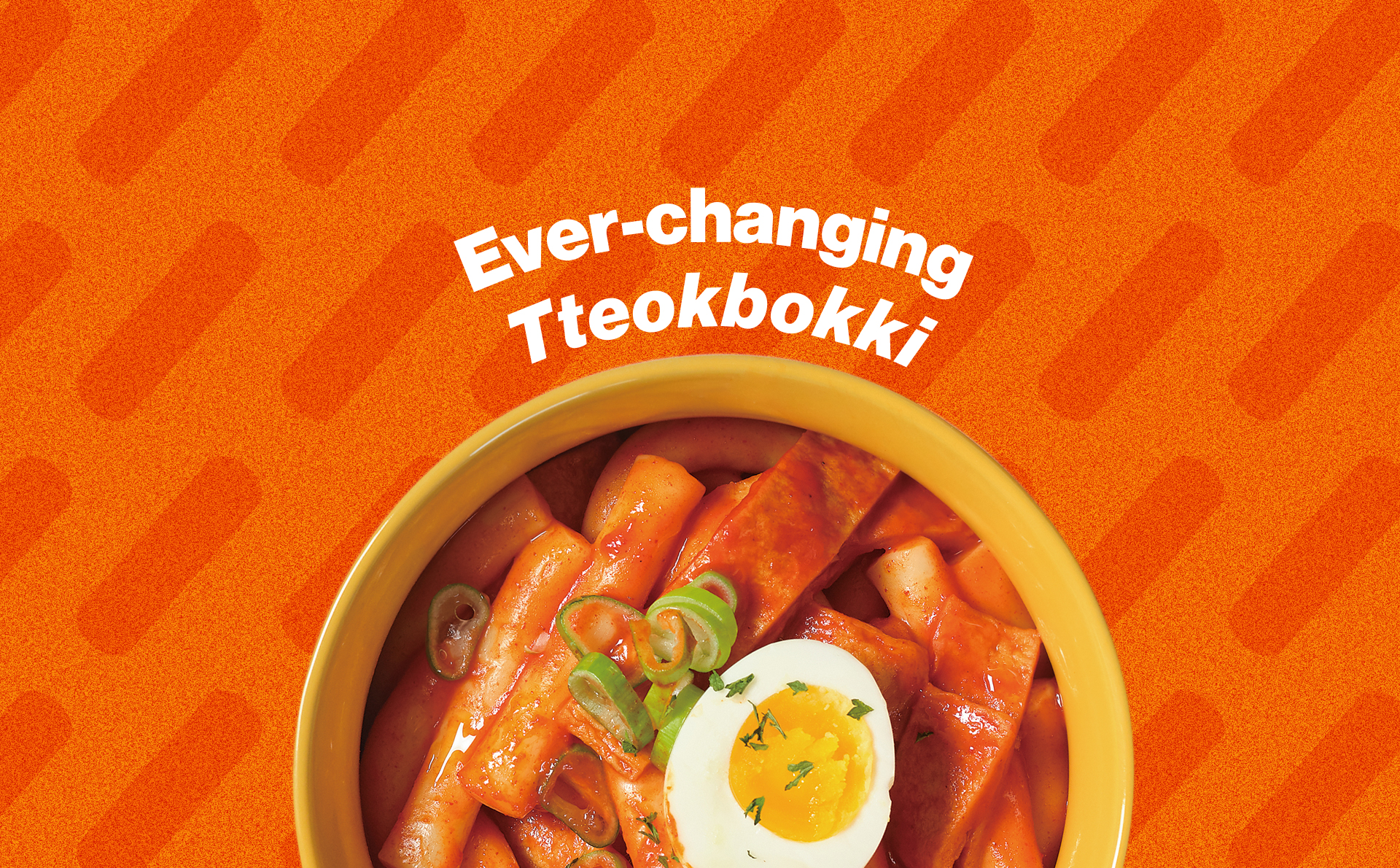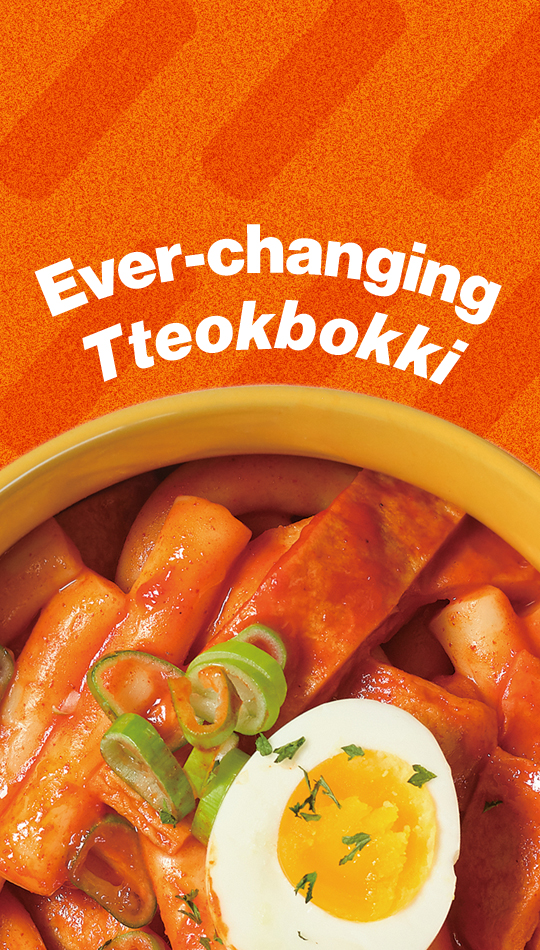There’s no limit to how a dish can be prepared; ingredients are added and subtracted, endlessly varying. Among such diverse dishes, tteokbokki (stir-fried rice cake) stands out. Depending on the sauce, type of tteok (rice cakes), toppings and cooking method, its appearance can vary—but let’s delve into this dish known as tteokbokki.


Writer. Jang Heejoo
The Origin of Tteokbokki
Tteokbokki—a staple dish for Koreans—is commonly served in school cafeterias, readily accessible in local supermarkets and convenience stores, and even available for fast delivery, garnering affection from people of all ages and genders.
What’s the general flavor profile of the beloved tteokbokki?—Its essence lies in the sauce, comprising gochujang (red chili paste), red pepper powder, sugar, ganjang (soy sauce) and more, delivering a spicy-sweet taste. Tteokbokki boasts cylindrical tteok bathed in this sauce base alongside scallions, fish cakes and other veggies, resulting in a chewy texture and a rich broth. Overall, it’s a tantalizing and addictive culinary experience.
However, the original tteokbokki did not look and taste the way it does today. It originated from the meaning of “stir-frying tteok” (tteok meaning rice cakes and bokki meaning stir-fry). It traces its roots back to steamed tteok known as tteokjjim, with its seasoning originally being ganjang-based rather than the red spicy sauce based on the gochujang we know today. The typical red tteokbokki we enjoy now emerged around the 1960s, born from the hands of a Korean merchant. While eating a meal, the merchant ate a tteok with chunjang (black soybean paste), but surprisingly, the taste was delightful. Inspired by this flavor, the merchant began seasoning the tteok with gochujang instead of chunjang, leading to the birth of the iconic gochujang tteokbokki.
The inception of red tteokbokki began at a small restaurant in Seoul’s Shindang-dong Village—gradually gaining traction. The alley where the restaurant resided earned the moniker “Tteokbokki Alley,” propelling tteokbokki restaurants to proliferate nationwide as a beloved, affordable delicacy.
A Spectrum of Tteokbokki
Since the emergence of gochujang tteokbokki, the dish has undergone continuous evolution. It remains in a state of perpetual change—so much so that listing the varieties of tteokbokki proves challenging even for Koreans.
Tteokbokki varieties can be classified by the consistency of the broth—while those with a thick and hearty broth are typically referred to as regular tteokbokki, those with a thin and plentiful broth are known as gungmultteokbokki. Conversely, if the dish lacks broth and the tteok are stir-fried with oil and sauce, it becomes gireumtteokbokki.
It can also be classified by the type of tteok—such as those made from rice versus wheat. Wheat tteok are made from wheat flour. While tteok have a distinct nutty flavor, wheat tteok boast a chewier texture.
Tteokbokki can also vary depending on the sauce used—ranging from the traditional gungjungtteokbokki (royal stir-fried rice cake) with its ganjang base, hailing from the royal court, to the Korean-style rosé sauce tteokbokki, blending gochujang and fresh cream (typically rosé sauce comprises tomato and fresh cream) and jjajangtteokbokki, infused with black bean paste, offers further variations to tantalize the taste buds.
Aside from these, there is a plethora of tteokbokki variations that are indescribable. In Korea, tteokbokki spots are so common that you can find one in almost every alley. However, each one boasts a unique flavor profile, dictated by factors like the broth’s composition, the balance of red pepper powder to gochujang, and the cooking duration.
That’s why there are folks crisscrossing the country in search of top-notch tteokbokki spots, influencers who’ve made a career out of critiquing this dish, and there’s even a nationwide tteokbokki hotspot list and map. If you’re scratching your head over the appeal of these red, slender morsels—and why countless Koreans just can’t quit them—why not dive in and take a bite? Join the ranks of tteokbokki aficionados before you know it.
Rosé Tteokbokki
25 mins.
INGREDIENTS
150 ml fresh cream, 250 ml milk, 1 tablespoon gochujang, 1 tablespoon red pepper flakes, 2 tablespoons cooking wine, 1/2 tablespoon curry powder, 200 g tteok, 1/4 green onion, 1/4 onion, 3 slices bacon, 5 sausages, cooking oil, 1 boiled egg, parsley powder
- Soak the tteok in cold water for 30 minutes.
- Finely slice the onion, green onion and bacon, and score the sausages.
- Heat oil in a pot and sauté the onion, green onion, bacon and sausages.
- Then, add milk, fresh cream, red pepper flakes, gochujang, cooking wine, curry powder and the soaked tteok, and bring to a boil.
- Boil until the sauce thickens, then transfer to a serving dish. Garnish with a boiled egg and sprinkle with parsley powder on top.
Pizza Cup Tteokbokki
30 mins.
INGREDIENTS
5 tablespoons tomato sauce, 3 tablespoons corn syrup, 1 tablespoon gochujang, 1 tablespoon minced garlic, 1/2 onion (minced), 100 g canned corn, 3 slices bacon, 200 g tteok, 100 g mozzarella cheese, 3 pieces tortilla, cooking oil, parsley powder, olives
- Soak the tteok in cold water for 30 minutes and drain the canned corn in a colander.
- In a greased pan, sauté the onion and garlic. Then, add bacon, tomato sauce, corn syrup, gochujang and tteok. Mix well and simmer, adding water little by little until the tteok is tender.
- Cut the tortillas and place them in a muffin pan.
- Arrange the tteokbokki, canned corn and pizza cheese sequentially over the tortillas, then garnish with parsley and olives.
- Bake in a preheated oven at 180 degrees Celsius for 15 minutes.
